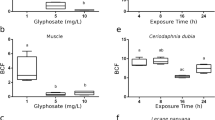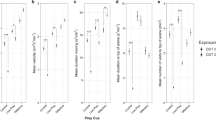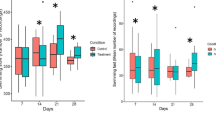Abstract
The effects of chemicals on biotic interactions, such as competition and predation, have rarely been investigated in aquatic ecotoxicology. This study presents a new approach for the investigation of predator–prey interactions between zebrafish (Danio rerio) and midge larvae (Chironomus riparius) impaired by chlorpyrifos (CHP), a neurotoxic insecticide. With a simple experimental design including four different treatments: (1) control, (2) predator exposed, (3) prey exposed and (4) both, predator and prey, exposed, we were able to detect by visual observation an increase in the feeding rate of zebrafish preying on exposed chironomids after acute (2 h) exposure to 6 μg/l CHP. Previously, a decrease in the burrowing behaviour of exposed chironomid larvae was observed. However, when pre-exposing simultaneously both predators and prey, no significant differences in the feeding rate of zebrafish were observed. This suggests an impairment in prey recognition of the exposed zebrafish. At a lower CHP concentration (1 μg/l), no differences in feeding rate of zebrafish were observed. We therefore propose the use of trophic interactions as parameters in higher tier studies for chemical testing and evaluation of ecotoxicological risk assessment.




Similar content being viewed by others
References
Ankley GT, Call DJ, Cox JS, Kahl MD, Hoke RA, Kosian PA (1994) Organic carbon partitioning as a basis for predicting the toxicity of chlorpyrifos in sediments. Environ Toxicol Chem 13:621–626
Bailey HC, Deanovic L, Reyes E, Kimball T, Larson K, Cortright K, Connor V, Hinton DE (2000) Diazinon and chlorpyrifos in urban waterways in Northern California, USA. Environ Toxicol Chem 19:82–87
Baker RL, Ball SL (1995) Microhabitat selection by larval Chironomus tentans (Diptera: Chironomidae): effects of predators, food, cover and light. Freshw Biol 34:101–106
Béchard KM, Gillis PL, Wood CM (2008) Trophic transfer of Cd from larval chironomids (Chironomus riparius) exposed via sediment or waterborne routes, to zebrafish (Danio rerio): tissue-specific and subcellular comparisons. Aquat Toxicol 90:310–321
Begon M, Townsend C, Harper J (2006) Ecology. From individuals to ecosystems. Blackwell, Malden, MA
Belden JB, Lydy MJ (2000) Impact of atrazine on organosphosphate insecticide toxicity. Environ Toxicol Chem 19:2266–2274
Börries A (2006) Das Zierfischverzeichnis: Zebrabärbling/Zebrafisch Danio rerio. http://www.zierfischverzeichnis.de/klassen/pisces/cypriniformes/cyprinidae/danio_rerio.htm. Retrieved 15 Jun 2010
Bridges CM (1999) Predator-prey interactions between two amphibian species: effects of insecticide exposure. Aquat Ecol 33:205–211
Brown GE (2003) Learning about danger: chemical alarm cues and local risk assessment in prey fishes. Fish Fish 4:227–234
Callaghan A, Hirthe G, Fisher T, Crane M (2001) Effect of short-term exposure to chlorpyrifos on developmental parameters and biochemical biomarkers in Chironomus riparius Meigen. Ecotoxicol Environ Saf 50:19–24
Dell`Omo G (2002) Behavioural ecotoxicology. Wiley, Chichester
Dow AgroSciences (2010) What is chlorpyrifos? http://www.chlorpyrifos.com/. Retrieved 15 Jun 2010
Fisher TC, Crane M, Callaghan A (2000) An optimized microtiterplate assay to detect acetylcholinesterase activity in individual Chironomus riparius Meigen. Environ Toxicol Chem 19:1749–1752
Forsyth DJ, James MR (1988) The Lake Okaro ecosystem 2. Production of the chironomid Polypedilum pavidus and its role as food for two fish species. N Z J Mar Freshwater Res 22:327–335
Gerhardt A (2007) Aquatic behavioural ecotoxicology—prospects and limitations. Hum Ecol Risk Assess 13:481–491
Gilinsky E (1984) The role of fish predation and spatial heterogeneity in determining benthic community structure. Ecology 65:455–468
Gilliom RJ, Barbash JE, Crawford CG, Hamilton PA, Martin JD, Nakagaki N, Nowell LH, Scott JC, Stackelberg PE, Thelin GP, Wolock DM (2006) Pesticides in the nation’s streams and ground water, 1992–2001: the quality of our nation’s waters. U.S. Geological Survey Circular 1291
Gómez A, Cecchine G, Snell T (1997) Effect of pentachlorophenol on predator-prey interaction of two rotifers. Aquat Toxicol 37:271–282
Goyke A, Hershey A (1992) Effects of fish predation on larval chironomid (Diptera: Chironomidae) communities in an arctic ecosystem. Hydrobiologia 240:203–211
Grippo MA, Heath AG (2003) The effect of mercury on the feeding behavior of fathead minnows (Pimephales promelas). Ecotoxicol Environ Saf 55:187–198
Hamers T, Krogh PH (1997) Predator-prey relationships in a two-species toxicity test system. Ecotoxicol Environ Saf 37:203–212
Hershey AE (1987) Tubes and foraging behavior in larval Chironomidae: implications for predator avoidance. Oecologia 73:236–241
Hölker F, Stief P (2005) Adaptive behaviour of chironomid larvae (Chironomus riparius) in response to chemical stimuli from predators and resource density. Behav Ecol Sociobiol 58:256–263
Jin-Clark Y, Lydy MJ, Yan Zhu K (2002) Effects of atrazine and cyanizine on chlorpyrifos toxicity in Chironomus tentans (Diptera:Chironomidae). Environ Toxicol Chem 21:598–603
Kamrin MA (1997) Pesticide profiles: toxicity, environmental impact, and fate. Lewis Publishers, Boca Raton, New York
Kienle C, Köhler H-R, Gerhardt A (2009) Behavioural and developmental toxicity of chlorpyrifos and nickel chloride to zebrafish (Danio rerio) embryos and larvae. Ecotoxicol Environ Saf 72:1740–1747
Lawrence C (2007) The husbandry of zebrafish (Danio rerio): a review. Aquaculture 269:1–20
Levin ED, Chrysanthis E, Yacisin K, Linney E (2003) Chlorpyrifos exposure of developing zebrafish: effects on survival and long-term effects on response latency and spatial discrimination. Neurotoxicol Teratol 25:51–57
Levin ED, Swain HA, Donerly S, Linney E (2004) Developmental chlorpyrifos effects on hatchling zebrafish swimming behavior. Neurotoxicol Teratol 26:719–723
Lima SL (2002) Putting predators back into behavioral predator-prey interactions. Trends Ecol Evol 17:70–75
Lydy MJ, Belden JB, Ternes MA (1999) Effects of temperature on the toxicity of M-parathion, chlorpyrifos, and pentachlorobenzene to Chironomus tentans. Arch Environ Contam Toxicol 37:542–547
Macchiusi F, Baker RL (1992) Effects of predators and food availability on activity and growth of Chironomus tentans (Chironomidae: Diptera). Freshw Biol 28:207–216
Moore MT, Huggett DB, Gillespie JWB, Rodgers JJH, Cooper CM (1998) Comparative toxicity of chlordane, chlorpyrifos, and aldicarb to four aquatic testing organisms. Arch Environ Contam Toxicol 34:152–157
Nyholm JR, Norman A, Norrgren L, Haglund P, Andersson PL (2008) Maternal transfer of brominated flame retardants in zebrafish (Danio rerio). Chemosphere 73:203–208
OECD (1992) OECD Guideline for testing of chemicals 203: Fish, Acute Toxicity Test
Pinder LCV (1986) Biology of freshwater Chironomidae. Annu Rev Entomol 31:1–23
Power ME (1990) Effects of fish in river food webs. Science 250:811–814
Rahel FJ, Stein RA (1988) Complex predator-prey interactions and predator intimidation among crayfish, piscivorous fish, and small benthic fish. Oecologia 75:94–98
Richardson RJ (1995) Assessment of the neurotoxic potential of chlorpyrifos relative to other organophosphorus compounds: a critical review of the literature. J Toxicol Environ Health 44:135–165
Roex EWM, de Vries E, van Gestel CAM (2002) Sensitivity of the zebrafish (Danio rerio) early life stage test for compounds with different modes of action. Environ Pollut 120:355–362
Scheil V, Köhler H-R (2009) Influence of nickel chloride, chlorpyrifos, and imidacloprid in combination with different temperatures on the embryogenesis of the Zebrafish Danio rerio. Arch Environ Contam Toxicol 56:238–243
Schuler L, Trimble A, Belden J, Lydy M (2005) Joint toxicity of triazine herbicides and organophosphate insecticides to the midge Chironomus tentans. Arch Environ Contam Toxicol 49:173–177
Schulz R (2001) Rainfall-induced sediment and pesticide input from orchards into the lourens river, western cape, south Africa: importance of a single event. Water Res 35:1869–1876
Schulz R, Dabrowski JM (2001) Combined effects of predatory fish and sublethal pesticide contamination on the behavior and mortality of mayfly nymphs. Environ Toxicol Chem 20:2537–2543
Sheipline R (1993) Background information on nine selected pesticides. California Regional Water Quality Control Board, Sacramento
Sih A (1982) Foraging strategies and the avoidance of predation by an aquatic insect, Notonecta hoffmanni. Ecology 63:786–796
Stief P, Hölker F (2006) Trait-mediated indirect effects of predatory fish on microbial mineralization in aquatic sediments. Ecology 87:3152–3159
Taylor EJ, Morrison JE, Blockwell SJ, Tarr A, Pascoe D (1995) Effects of lindane on the predator-prey interaction between Hydra oligactis Pallas and Daphnia magna Strauss. Arch Environ Contam Toxicol 29:291–296
Thorp JH, Bergey EA (1981) Field experiments on interactions between vertebrate predators and larval midges (Diptera: Chironomidae) in the littoral zone of a reservoir. Oecologia 50:285–290
Townsend C, Harper J, Begon M (2003) Ökologie. Springer-Verlag, Berlin
Tseng M (2003) Life-history responses of a mayfly to seasonal constraints and predation risk. Ecol Entomol 28:119–123
U.S.-EPA (1986) Ambient water quality criteria for chlorpyrifos. Office of Water, Washington, DC
Weis JS, Samson J, Zhou T, Skurnick J, Weis P (2001) Prey capture ability of mummichogs (Fundulus heteroclitus) as a behavioral biomarker for contaminants in estuarine systems. Can J Fish Aquat Sci 58:1442–1452
Acknowledgments
We are grateful to Niels Dieter for assistance with the experimental procedure. Also the Max-Planck-Institute for Developmental Biology in Tübingen is thanked for providing the fish.
Author information
Authors and Affiliations
Corresponding authors
Additional information
Miriam Langer-Jaesrich and Cornelia Kienle have contributed equally to this paper and share first authorship.
Rights and permissions
About this article
Cite this article
Langer-Jaesrich, M., Kienle, C., Köhler, HR. et al. Impairment of trophic interactions between zebrafish (Danio rerio) and midge larvae (Chironomus riparius) by chlorpyrifos. Ecotoxicology 19, 1294–1301 (2010). https://doi.org/10.1007/s10646-010-0516-x
Accepted:
Published:
Issue Date:
DOI: https://doi.org/10.1007/s10646-010-0516-x




